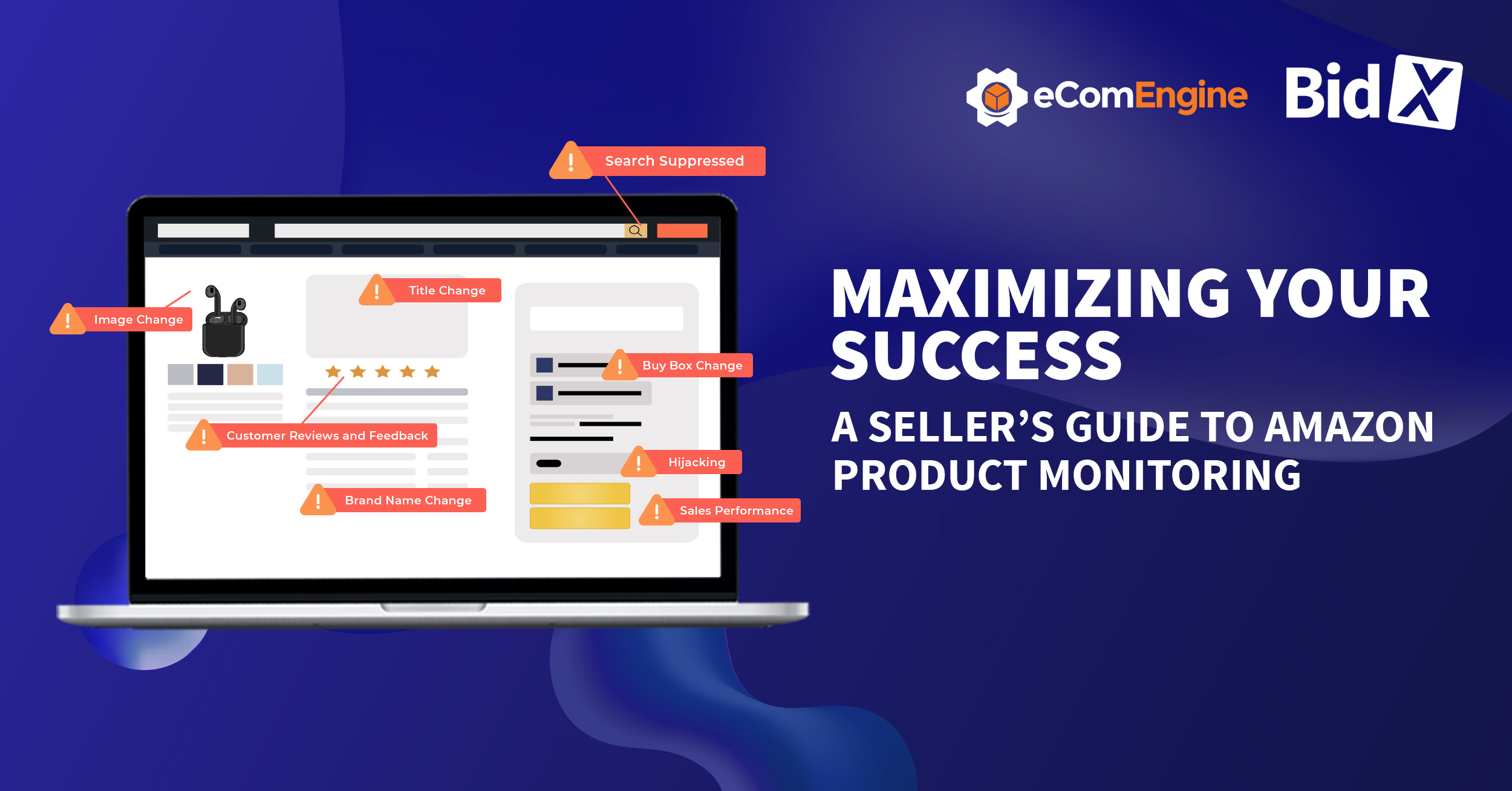Maximizing Your Success: A Seller’s Guide to Amazon Product Monitoring
There are countless ways to lose sales on Amazon. Did you know that your listing can get hijacked and modified by unethical competitors? Or that Amazon can mistakenly flag your product as 'adult' without even telling you?
This is on top of everyday issues like running out of stock, getting negative customer reviews, or losing the Buy Box to a normal competitor. Obviously, you need to monitor your products to prevent or fix these issues. In this article, we'll explain in more depth why it's important to monitor your products and how to start doing that.
Key Metrics to Monitor on Amazon
eCommerce is constantly changing. A product highlighted on TikTok may go viral, leading to an increase in sales velocity. If this happens to your product unexpectedly, you could run out of stock, causing your product to become unavailable. Although eCommerce is unpredictable, paying attention to consumer behavior, market trends, and your competitors can help you be prepared to pivot quickly whenever something changes.
On top of that, you need to be paying careful attention to your Seller Central account. Key metrics to consider include:
- Sales performance
- Inventory performance
- Customer reviews and feedback
- Return rates for your products
- Advertising performance
- Shipping performance
- Account Health Rating (AHR)
Amazon provides sales data that you can filter and search in the Business Reports section of Seller Central. The Manage Inventory page provides up-to-date details and recommendations regarding inventory performance, allowing you to quickly make changes as needed.
The Account Health dashboard shows how you’re performing across customer service, policy compliance, and shipping. You can view seller feedback in the Feedback Manager and reviews in Voice of the Customer or within the Customer Reviews page on the Brand Dashboard if you’re brand registered. Returns reports and Amazon Advertising reports provide detailed information to help you understand how your business is performing.
Tracking your metrics and performance over time provides a benchmark to measure your success on Amazon. It can also help you find opportunities for growing your business.
Assess the Competition
The Product Opportunity Explorer in Seller Central offers a wide range of information about your current niche or one you’re interested in. It includes details about search volume, areas where a higher quality product could thrive, pricing, demand, customer sentiment, and more. Using this feature can help you quickly understand your market share and how you stack up against your competitors. It can also help you identify new products you might want to consider selling.
Check out how your competitors are marketing their products. How engaged is their audience? Where are they investing their time? Are they working with influencers or trying new techniques to reach customers? What can you learn from their successes and failures? Use that information to help you decide where to focus your marketing efforts.
Pricing is another important piece of Amazon product monitoring. Are your prices aligned with your competitors? What makes your products stand out? Do you need to raise or lower your prices to remain competitive?
Keep Your Listings Active
Changes to your listings – whether you make them or someone else does – can lead to problems for your sales and your overall reputation on Amazon. Approximately 50% of all US shoppers begin their product searches on Amazon, so if your product isn’t showing up in the search results, you’re missing sales opportunities and handing your hard-earned traffic over to your competition.
Listings can be search-suppressed if they fail to meet Amazon’s guidelines. Images that don’t meet Amazon’s requirements, insufficient product descriptions, duplicate listings, and titles that are too long are a few examples of common reasons your Amazon listing could be suppressed. Unfortunately, Amazon doesn’t notify you when this happens. You’ll need to check to see if any of your listings are suppressed by going to the Manage Inventory page in Seller Central; if listings are suppressed or inactive you’ll see a hyperlink at the top of the page that says “Search Suppressed and Inactive Listings” and it will take you to the Fix Your Products page to learn more.
Your listing may become inactive (meaning it’s not available for purchase) if you’re experiencing stocking problems or manufacturer changes. Policy violations can also cause your listing to become inactive.
Amazon listing hijacking is a serious problem, and being on the lookout for listing changes that might signal hijacker activity is an important part of your Amazon product monitoring process. Unauthorized changes to your title, images, brand name, and other listing details could indicate that something is off. If you sell your own brand, a change to the number of sellers on your listing might indicate that someone is selling a counterfeit version of your product. These tend to be of much lower quality, and sometimes a sudden increase in negative reviews is the first obvious sign that something is wrong.
Buy Box changes are also notable. If you’re a private label seller, losing the Buy Box could be a sign of hijacker activity. You can also lose the Buy Box due to Buy Box suppression because your product is listed for a lower price on a different platform.
Keeping track of listing changes is challenging because it’s a very manual process. Seller Central doesn’t provide a comprehensive report or overview to alert you to these types of changes, but eComEngine does. You can monitor your Amazon listings 24/7 and receive alerts along with recommendations for what to do next when something is amiss.
Manage Your Amazon Reputation
Amazon has built a trusted eCommerce platform thanks to a focus on customer experience and strict guidelines for sellers. Amazon shoppers expect their orders to arrive on time, undamaged, and as described on the product detail page. As a seller, your goal is to ensure that customers are satisfied with your products and their purchasing experience.
Your seller feedback rating is all about how customers perceive you as a seller, from delivery experience to professionalism. Maintaining a positive seller feedback rating is essential; Amazon uses this metric to determine how well you’re meeting its standards and as an eligibility requirement for certain programs. You can even be suspended or banned from selling if your feedback rating falls below performance targets. For example, you’re required to maintain an Order Defect Rate that is below 1%.
Amazon customer reviews offer insights into how customers perceive your products. Evaluating your top negative reviews can help you identify areas for improvement. In some cases, you may need to revisit your listing content to make sure you’re providing an accurate description. A decline in reviews may indicate that your product is approaching the end of its life cycle or that industry trends are changing. Regularly monitoring your reviews and your competitors’ reviews can help you stay competitive.
Having a process to automate feedback and review requests is a great way to save time while building and protecting your seller reputation. FeedbackFive makes the process simple and keeps you compliant with Amazon’s review policies.
Another great way to protect your Amazon reputation is to sign up for Amazon’s Brand Registry program. It offers additional control over your listings and powerful marketing tools to help you continue to grow on Amazon’s platform. It also includes a dedicated team focused on assisting sellers with intellectual property infringement claims.
Build Your Amazon Product Monitoring Processes
Understanding your competition and how your products are performing on Amazon in comparison to them is the foundation for continued growth. Building processes for Amazon product monitoring that work for your business is key. Automated solutions such as Amazon listing alerts and FBA inventory management recommendations can save you time so you can stay focused on what lies ahead. eComEngine has been providing software solutions for Amazon sellers since 2007 and offers a wealth of free resources to make selling on Amazon simple.
About the author:

Becky Trowbridge is the Digital Marketing Manager at eComEngine. Her mission is to empower Amazon sellers with the information they need to be successful in a competitive market. When she's not creating content, she enjoys spending time outdoors, trying new recipes, and reading.





